My map page on Shopify is blank or has the wrong content
With Shopify’s new Online Store 2.0 theme editor, it’s possible to create custom page layouts on Shopify more easily than ever. However, a common theme misconfiguration can cause some pages on your site (like your map page) to show up blank or with the wrong content.
Note: This article applies if your store locator isn't showing up on the page at all (not even the loading message). If you see the map section but the roadmap behind the map pins is missing, see this article instead.
Introduction
On Shopify, it’s possible to set up multiple page layouts by creating “templates” in your theme.
Each content page on your site (e.g. “About Us”, “Shipping & Returns”, etc) is assigned a template which controls the page’s overall layout and determines what content is included when a customer views the page on your site.
Traditionally, this template would usually include a special section for the page content, which would show the text you type in Shopify under “Online store > Pages”. For example, you could create a template with a header image on top, and the page content below. The header image would then be the same on all pages using that template, while the page content itself would be different for each page.
However, with Shopify’s new Online Store 2.0 editor, it’s become more common to build an entire page directly within a template.
The problem happens when the “Default page” template in your theme is modified accidentally. The “default” template is used for all new pages in your theme, and usually for your map page as well. If the special section that shows the page content is removed from the default page template, the final page on your site won’t show the actual page content (i.e. your store map) anywhere. Additionally, if another layout was created in the default template, your map page might seem to be showing a totally different page when you view your site.
To fix the issue for both your Stockist map page as well as any other new pages created in the future, the best approach is to fix the default page template to make sure it include the special "page content" section within the layout.
Confirming the issue
First, it’s a good idea to confirm whether this issue is affecting your map page.
Find your map page
In your Shopify admin, open Online Store > Pages:
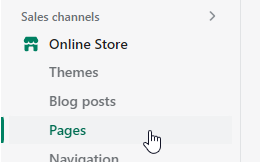
Next, find the map page in the list. If you installed Stockist from the Shopify App Store, a new page called Store Locator was added to your site when Stockist was first installed:
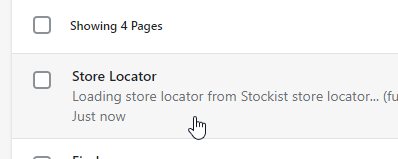
If you previously set up a different store locator app, your site could potentially have multiple pages called Store Locator. In this case, the one with the Stockist map will usually mention Stockist in the snippet under the title:

Check which template is in use
Once you’ve opened your map page, check the Theme template option in the right-hand column:
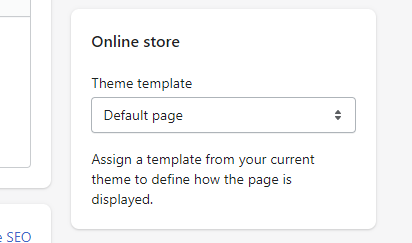
If this is already set to Default page, it’s correct and you can continue to the next section.
If this is set to a different template, change it to Default page and then save the page. Wait 60 seconds or so, then click View page at the top to check the page on your site to see if the map is showing up:

If you still don’t see the map on your live site after choosing the Default page template, continue to the next section.
Checking your default page template
If you’ve confirmed that your map page is set to use the Default page template, but the map still isn’t showing up, the next step is to check that the default page template in your theme is set up correctly.
In your Shopify admin, open Online Store > Themes:
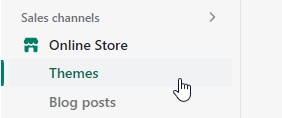
Click Customize next to your live theme:

In the template picker at the top of the theme editor, select Pages > Default page:
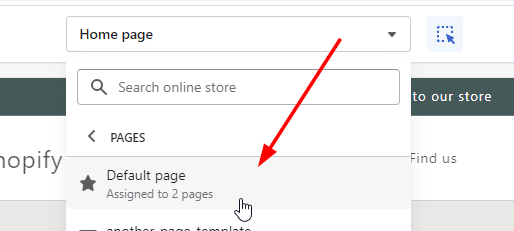
The left side of the theme editor shows the sections that have been added to the template:
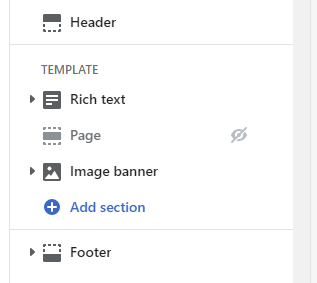
The relevant section is the one called Page. If this section shows an eyeball with a slash through it, this means that the page content has been hidden and won’t appear when any page using this template is viewed on your website:

If the Page section is hidden, continue below for details on how to fix it.
Fixing your default page template
If the Page section of your Default page template is currently hidden, we recommend restoring the original behavior of your theme by un-hiding this section. This will allow the right content to show up for your map page as well as any new pages added to your site in the future.
There are two possibilities here depending on how your default page template is currently set up:
- If the default page template isn’t showing any content, we can simply enable the Page section to make the content visible.
- If the default page template has been edited to show the content of a different page and you need to preserve this content, we’ll need to copy the content to a new template first. This will save a copy of the page you’ve built before we fix the default template.
The second situation sometimes comes up because it’s easy to lose track of what template you’re changing in the Shopify theme editor. Sometimes folks have built a custom “About us” or “Our story” page for their site, but accidentally changed the default template instead of creating a new template for this specific page.
Option 1: No extra content
If the default page template isn’t showing any content that you need to save, you can just click the eyeball icon next to the Page section to make it visible:

Once this is done, click Save in the top-right corner to update your theme:

Note that it might take a few minutes for the change to appear on your live site due to caching on Shopify’s end.
After a couple of minutes, check the map page on your live site again to see if the map is showing up correctly now. If you still see an issue at this point, please reach out to our support team and we’re happy to assist.
Option 2: The default page template shows the content of a different page
If your default page template has been edited to show the content for a different page on your site and you still need this content, we’ll need to move the content to a new template first. We’ll follow these steps:
- Copy the content to a new template
- Update the relevant page(s) to use the new template
- Fix your default page template to restore the correct behavior
We have the details of each step below:
1. Copy the content to a new template
First, make sure you’re in the theme editor. If not, click Online Store > Themes and then click Customize next to your live theme.
In the template picker at the top of the page, choose Pages > Create template:
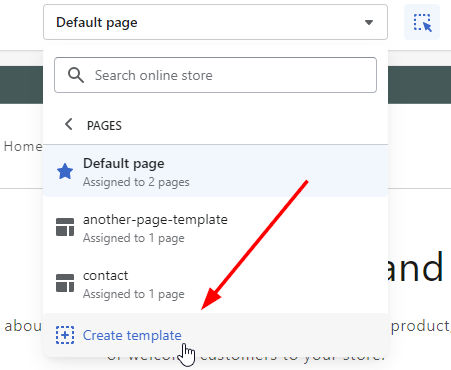
You'll be prompted to create the new template. Under Name choose a name for the new template that describes the page that’s currently shown in the default template. For example, if the default template was showing an About us page, you could call the template About us. For Based on, choose Default page:
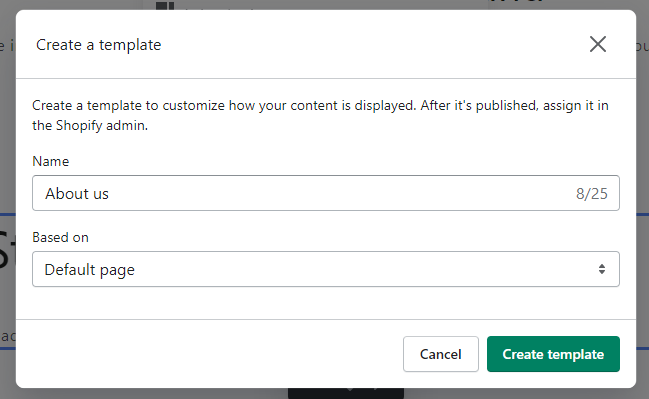
When you’re done, click Create template. This will create a new template with a copy of the content that’s currently on your Default page template.
2. Update the relevant pages
The next step is to update the pages on your site that need to show this content to use the new template we just created.
Under Online Store > Pages in your Shopify admin, find the page that should display the content of the template we just created:

Click on the page to edit it, and then in the Theme template option, select the name of the new template you just created (the format may have been changed to be lowercase with hyphens):
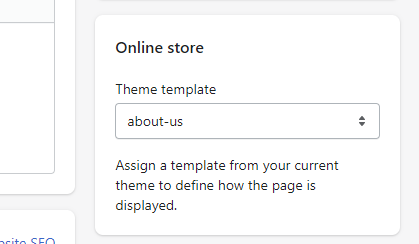
Once this has been changed, save the page to update it. Wait a few minutes, then check the page on your live site. The page should show the same content that it previously did. If not, change the Theme template option back to the previous setting, and please get in touch for assistance.
3. Fix your default template
Now that we’ve copied the custom content into a new template, we’re ready to update the default page template to restore the original behavior.
We’ll need to hide all of the sections of this template except for the Page section.
In your Shopify admin, open Online Store > Themes, then click Customize next to your live theme. Then, in the template picker at the top of the theme editor, select Pages > Default page:

In the list of sections on the left-hand side, make the Page section visible by clicking on the eyeball icon next to the name:

Once this is done, the icon should show an un-slashed eyeball when your mouse is over the name:

Then, update all of the other sections (except the Page section) to hide them. Hover over the name of each other section and click on the eyeball icon so that the slash appears:

Once this is done, all of the sections except for the Page section should be hidden:
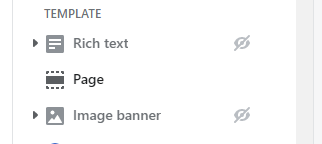
At this point you can preview the changes with the map page to check that things look correct. In the Preview selector at the top left, choose the Store Locator page (or whatever page shows your map) and check that things appear properly:

If you see your store map or the "Loading store locator..." message, you should be set to save your theme. The full map may not always load in the theme editor.
If things look correct, click Save in the top-right corner to update your theme:

We hope this was helpful! Feel free to get in touch if you have any questions or run into difficulty.























